Combination puzzle
A combination puzzle, also known as a sequential move puzzle, is a puzzle which consists of a set of pieces which can be manipulated into different combinations by a group of operations. Many such puzzles are of a polyhedral shape, and consist of multiple layers of pieces along each many axes which can rotate independently of each other.
| Part of a series on |
| Puzzles |
|---|
 |
.jpg.webp)
Description
A combination puzzle is solved by achieving a particular combination starting from a random (scrambled) combination. Often, the solution is required to be some recognisable pattern such as "all like colours together" or "all numbers in order". The most famous of these puzzles is the original Rubik's Cube, a cubic puzzle in which each of the six faces can be independently rotated. Each of the six faces is a different colour, but each of the nine pieces on a face is identical in colour, in the solved condition. In the unsolved condition colours are distributed amongst the pieces of the cube. Puzzles like the Rubik's Cube which are manipulated by rotating a section of pieces are popularly called twisty puzzles. They are often face-turning, but commonly exist in corner-turning and edge-turning varieties.
The mechanical construction of the puzzle will usually define the rules by which the combination of pieces can be altered. This leads to some limitations on what combinations are possible. For instance, in the case of the Rubik's Cube, there are a large number of combinations that can be achieved by randomly placing the coloured stickers on the cube, but not all of these can be achieved by manipulating the cube rotations. Similarly, not all the combinations that are mechanically possible from a disassembled cube are possible by manipulation of the puzzle. Since neither unpeeling the stickers nor disassembling the cube is an allowed operation, the possible operations of rotating various faces limit what can be achieved.
Although a mechanical realization of the puzzle is usual, it is not actually necessary. It is only necessary that the rules for the operations are defined. The puzzle can be realized entirely in virtual space or as a set of mathematical statements. In fact, there are some puzzles that can only be realized in virtual space. An example is the 4-dimensional 3×3×3×3 tesseract puzzle, simulated by the MagicCube4D software.
Types
There have been many different shapes of Rubik type puzzles constructed. As well as cubes, all of the regular polyhedra and many of the semi-regular and stellated polyhedra have been made.
Regular cuboids
A cuboid is a rectilinear polyhedron. That is, all its edges form right angles. Or in other words (in the majority of cases), a box shape. A regular cuboid, in the context of this article, is a cuboid puzzle where all the pieces are the same size in edge length. Pieces are often referred to as "cubies".
| Picture | Data | Comments |
|---|---|---|
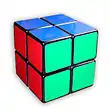 |
Commercial name: Pocket Cube |
Simpler to solve than the standard cube in that only the algorithms for the corner pieces are required. It is nevertheless surprisingly non-trivial to solve. |
 |
Commercial name: Rubik's Cube |
The original Rubik's Cube |
 |
Commercial name: Rubik's Revenge |
Solution is much the same as 3×3×3 cube except additional (and relatively simple) algorithm(s) are required to unscramble the centre pieces and edges and additional parity not seen on the 3x3x3 Rubik's Cube. |
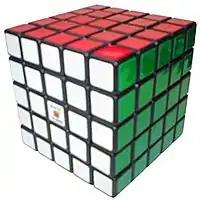 |
Commercial name: Professor's Cube |
Solution is much the same as 3×3×3 cube except additional (and relatively simple) algorithm(s) are required to unscramble the centre pieces and edges. |
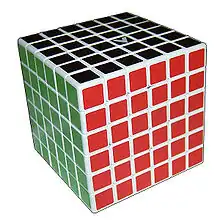 |
Commercial name: V-CUBE |
Panagiotis Verdes holds a patent to a method which is said to be able to make cubes up to 11×11×11. He has fully working products for 2×2×2 - 9×9×9 cubes. |
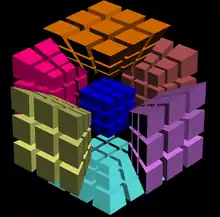 |
4-Dimensional puzzle |
This is the 4-dimensional analog of a cube and thus cannot actually be constructed. However, it can be drawn or represented by a computer. Significantly more difficult to solve than the standard cube, although the techniques follow much the same principles. There are many other sizes of virtual cuboid puzzles ranging from the trivial 3×3 to the 5-dimensional 7×7×7×7×7 which has only been solved twice so far.[1] |
|
Non-uniform cuboids |
Most of the puzzles in this class of puzzle are generally custom made in small numbers. Most of them start with the internal mechanism of a standard puzzle. Additional cubie pieces are then added, either modified from standard puzzles or made from scratch. The four shown here are only a sample from a very large number of examples. Those with two or three different numbers of even or odd rows also have the ability to change their shape. The Tower Cube was manufactured by Chronos and distributed by Japanese company Gentosha Education; it is the third "Okamoto Cube" (invented by Katsuhiko Okamoto). It does not change form, and the top and bottom colours do not mix with the colours on the sides. | |
|
Siamese cubes |
Siamese cubes are two or more puzzles that are fused so that some pieces are common to both cubes. The picture here shows two 3×3×3 cubes that have been fused. The largest example known to exist is in The Puzzle Museum [8] and consists of three 5×5×5 cubes that are siamese fused 2×2×5 in two places. there is also a "2 3x3x3 fused 2x2x2" version called the fused cube. The first Siamese cube was made by Tony Fisher in 1981.[9] This has been credited as the first example of a “handmade modified rotational puzzle”.[9] | |
|
Extended cubes |
These puzzles are made by bonding additional cubies to an existing puzzle. They therefore do not add to the complexity of the puzzle configuration, they just make it look more complex. Solution strategies remain the same, though a scrambled puzzle can have a strange appearance. | |
|
Commercial name: Boob cube |
Very possibly the simplest regular cuboid puzzle to solve. Completely trivial solution as the puzzle consists of only two cubies. | |
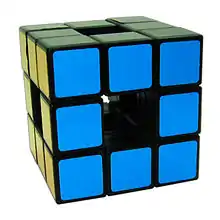 |
Commercial name: Void cube |
Solutions to this cube is similar to a regular 3x3x3 except that odd-parity combinations are possible with this puzzle. This cube uses a special mechanism due to absence of a central core. |
| Commercial name: Over The Top Geometric shape: Cube |
Experimental cube made by 3-D printing of plastic invented by Oskar van Deventer. Corners are much larger in proportion, and edge pieces match that larger dimension; they are narrow, and do not resemble cubes. The rest of the cubelets are 15x15 arrays on each side of the whole cube; as planned, they would be only 4 mm on a side. The original mechanism is a 3x3x3 core, with thin "vanes" for the center edges; the rest of the cubelets fill in the gaps. The core has a sphere at its center. As of 2018, it is being mass produced by the Chinese company YuXin.[10] |
Pattern variations
There are many puzzles which are mechanically identical to the regular cuboids listed above but have variations in the pattern and colour of design. Some of these are custom made in very small numbers, sometimes for promotional events. The ones listed in the table below are included because the pattern in some way affects the difficulty of the solution or is notable in some other way.
| Picture | Data | Comments |
|---|---|---|
|
|
Commercial name: Junior Cube |
Mechanically identical to the Pocket Cube. However, much easier to solve as it only uses two colours. |
|
Commercial name: Fooler Cube |
Mechanically identical to the standard 3×3×3 cube but not a real puzzle since all the faces are the same colour. There are also cubes which have only three colours, either one colour per pair of opposite faces or one colour per layer. Also known as the Dodo cube. | |
 |
Commercial name: Calendar Cube |
Mechanically identical to the standard 3×3×3 cube, but with specially printed stickers for displaying the date. Much easier to solve since five of the six faces are ignored. Ideal produced a commercial version during the initial cube craze. Sticker sets are also available for converting a normal cube into a calendar. |
|
Rubik's Cube for the blind |
Mechanically identical to the standard 3×3×3 cube. However the pieces are in some way tactile to allow operation by blind persons, or to solve blindfolded. The cube pictured is the original "Blind Man's Cube" made by Politechnika. This is coloured the same as the standard cube, but there is an embossed symbol on each square which corresponds to a colour. | |
 |
Commercial Name: Magic Cube |
Mechanically identical to the standard 3×3×3 cube. However, the numbers on the centre pieces force the solver to become aware that each one can be in one of four orientations, thus hugely increasing the total number of combinations. The number of combinations of centre face orientations is 46. However, odd combinations (overall odd number of rotations) of the centre faces cannot be achieved with legal operations. The increase is therefore x211 over the original making the total approximately 1024 combinations. This adds to the difficulty of the puzzle but not astronomically; only one or two additional algorithms are required to effect a solution. Note that the puzzle can be treated as a number magic square puzzle on each of the six faces with the magic constant being 15 in this case. |
|
Patterned cubes |
Mechanically identical to the standard 3×3×3 cube. The pattern, which is often a promotional logo or pictures of performers, will usually have the effect of making the orientation of the centre pieces 'count' in the solution. The solution is therefore the same as the 'Magic Square' cube above. | |
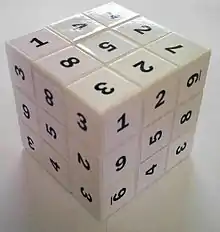 |
Commercial name: Sudoku Cube |
Identical to the Rubik's Cube in mechanical function, it adds another layer of difficulty in that the numbers must all have the same orientation and there are no colours to follow. The name reflects its superficial resemblance to the two-dimensional Sudoku number puzzle. |
Irregular cuboids
An irregular cuboid, in the context of this article, is a cuboid puzzle where not all the pieces are the same size in edge length. This category of puzzle is often made by taking a larger regular cuboid puzzle and fusing together some of the pieces to make larger pieces. In the formulae for piece configuration, the configuration of the fused pieces is given in brackets. Thus, (as a simple regular cuboid example) a 2(2,2)x2(2,2)x2(2,2) is a 2×2×2 puzzle, but it was made by fusing a 4×4×4 puzzle. Puzzles which are constructed in this way are often called "bandaged" cubes. However, there are many irregular cuboids that have not (and often could not) be made by bandaging.
| Picture | Data | Comments |
|---|---|---|
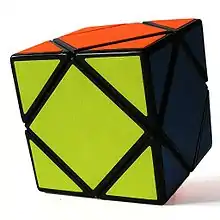 |
Commercial name: Skewb |
Similar to the original Rubik's Cube, the Skewb differs in that its four axes of rotation pass through the corners of the cube rather than the centres of the faces. As a result, it is a deep-cut puzzle in which each twist scrambles all six faces. |
|
Bandaged Cubes |
The example shown in the link is a simple example of a large number of bandaged cubes that have been made.
A bandaged cube is a cube where some of the pieces are stuck together. | |
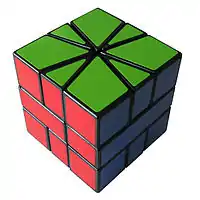 |
Commercial name: Square One |
A variation on the original Rubik's Cube where it can be turned in such a manner as to distort the cubical shape of the puzzle. The Square One consists of three layers. The upper and lower layers contain kite and triangular pieces. The middle layer contains two trapezoid pieces, which together may form an irregular hexagon or a square. Square One is an example of another very large class of puzzle — cuboid puzzles which have cubies that are not themselves all cuboid. |
| Golden Cube |
Commercial name: Tony Fisher's Golden Cube |
First rotational puzzle created that has just one colour,[9] requiring the solver to restore the puzzle to its original cube form without colour aids. |
|
Commercial name: Lan Lan Rex Cube (Flower Box) |
Other polyhedra
| Picture | Data | Comments |
|---|---|---|
 |
Commercial Name: Pyraminx |
Tetrahedral-shaped puzzle with axes on the corners and trivial tips. It was invented in 1970 by Uwe Mèffert. |
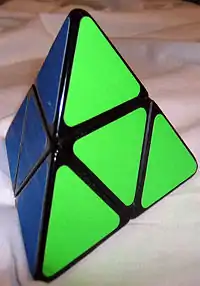 |
Commercial Name: Pyramorphix |
Edge turning tetrahedron shaped puzzle with a 2×2×2 cube mechanism. |
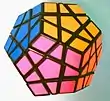 |
Commercial Name: Megaminx |
12-sided polyhedron puzzle similar to Rubik's Cube in operation and solution. |
 |
Commercial Name: Gigaminx, Teraminx, Petaminx |
Megaminx variants with multiple layers per face. The Gigaminx has 2 layers per face, for a total of 5 layers per edge; the Teraminx has 3 layers per face, 7 layers per edge; and the Petaminx has 4 layers per face, 9 layers per edge. |
 |
Commercial Name: Impossiball |
Rounded icosahedron puzzle similar to Pocket Cube in operation and solution. |
 |
Commercial Name: Alexander's Star |
12-sided Nonconvex uniform polyhedron puzzle similar to Rubik's Cube in operation and solution. |
 |
Commercial Name: BrainTwist |
The BrainTwist is a unique tetrahedral puzzle with an ability to "flip", showing only half of the puzzle at a time. |
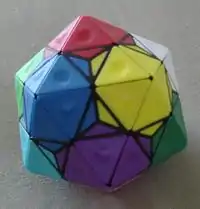 |
Commercial Name: Dogic |
The Dogic is an icosahedron cut into 60 triangular pieces around its 12 tips and 20 face centers. |
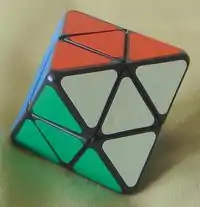 |
Commercial Name: Skewb Diamond |
An octahedral variation on the Skewb, it is a deep-cut puzzle very similar to the Skewb and is a dual-polyhedron transformation. |
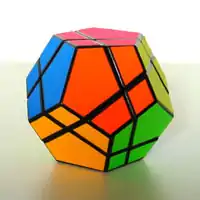 |
Commercial Name: Skewb Ultimate |
While appearing more difficult than the Skewb Diamond, it is functionally very similar to the Skewb and Skewb Diamond. The puzzle is cut in a different manner but the same solutions can be used to solve it by identifying what pieces are equivalent. Because faces of the Skewb Diamond correspond to corners of the Skewb Ultimate, an additional constraint on the orientation of these pieces appears. Any Skewb Diamond solution thus requires a few additions in order to solve the Skewb Ultimate. |
 |
Commercial Name: Barrel Cube |
Mechanically identical to the 3×3×3 cube. It does, however, have an interesting difference in its solution. The vertical corner columns are different colours to the faces and do not match the colours of the vertical face columns. The corner columns can therefore be placed in any corner. On the face of it, this makes the solution easier, however odd combinations of corner columns cannot be achieved by legal moves. The solver may unwittingly attempt an odd combination solution, but will not be aware of this until the last few pieces. |
 |
Commercial Name: Diamond Cube |
Mechanically identical to the 3×3×3 cube although the example pictured is easier to solve due to the restricted colour scheme. This puzzle is a rhombicuboctahedron but not a uniform one as the edge pieces are oblong rather than square. There is in existence a similar puzzle actually called Rhombicuboctahedron which is uniform. |
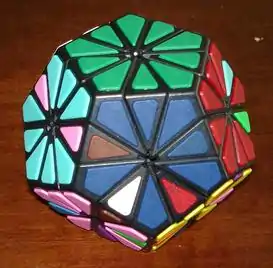 |
Commercial Name: Pyraminx Crystal |
A dodecahedron cut into 20 corner pieces and 30 edge pieces. It is similar to the Megaminx, but is deeper cut, giving edges that behave differently from the Megaminx's edges when twisted. |
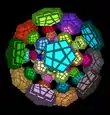 |
Commercial Name: Magic 120-cell |
Virtual 4-dimensional puzzle, the 4-D analogue of the Megaminx. |
Other geometric shapes
| Picture | Data | Comments |
|---|---|---|
 |
Commercial Name: Magic Ball |
Also known as Rubik's Sphere. Mechanically identical to the 3×3×3 cube in operation and solution. The only practical difference is that it is rather hard to grip. This accounts for the poor condition of this specimen, as the coloured stickers tend to get forced off in use. |
Non-Rubik style three-dimensional
| Picture | Data | Comments |
|---|---|---|
 |
Commercial Name: Minus Cube |
The Minus Cube is a 3D mechanical variant of the n-puzzle. It consists of a bonded transparent plastic box containing seven small cubes. There is an empty space the size of one small cube inside the box and the small cubes are moveable inside the box by tilting the box causing a cube to fall into the space. |
 |
Commercial Name: Rubik's Clock |
Rubik's Clock is a two-sided puzzle, each side presenting nine clocks to the puzzler. There are four wheels, one at each corner of the puzzle, each allowing the corresponding corner clock to be rotated directly. There are also four pins next to the center clock, which control the rotation of the four adjacent clock faces. |
 |
Commercial Name: Rubik's Snake |
Some would not count this as a combinational puzzle though it bears the Rubik name. Also known as Rubik's Twist. There is no one solution to this puzzle but multiple different shapes can be made.[11] |
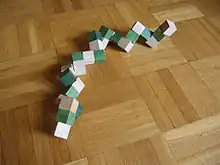 |
Commercial Name: Snake Cube |
The cubelets are connected by an elastic band running through them. They can rotate freely. The aim of the puzzle is to arrange the chain in such a way that they will form 3 x 3 x 3 or 4 x 4 x 4 cube. |
Two-dimensional
| Picture | Data | Comments |
|---|---|---|
 |
Sliding piece puzzle |
These ubiquitous puzzles come in many sizes and designs. The traditional design is with numbers and the solution forms a magic square. There have been many different designs, the example shown here uses graphic symbols instead of numbers. The solution requires that there are no repeated symbols in any row, column or diagonal. The picture shows the puzzle unsolved. |
|
Sliding piece puzzle with picture |
Mechanically, no different from the puzzle above. However, the picture on the pieces gives it something of the nature of a jigsaw puzzle, in addition to being a combination puzzle. Note that the picture consists of a multitude of polyhedra which have been made into Rubik puzzles. | |
 |
Fifteen puzzle |
The original sliding piece puzzle. |
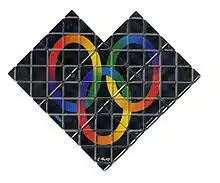 |
Rubik's Magic |
Not entirely 2D. Involves flipping parts back onto itself. |
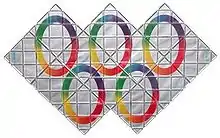 |
Rubik's Master Magic |
The five ringed version of the Rubik's Magic |
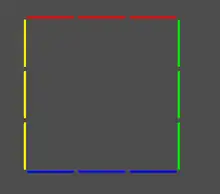 |
Commercial name:2D Magic Cube |
Another virtual puzzle in the Rubik series, but this time a very simple one. |
 |
Klotski |
A traditional sliding piece puzzle. There are now endless variations of this original puzzle implemented as computer games. |
|
Geranium |
A rotating piece puzzle. Some rank its difficulty very high compared to complex 3D puzzles.[12] There are other versions of this puzzle type including "Mini", "Pocket" and "Super", which have 2, 3 and 10 intersecting circles. There is an "Upgrade" mod which splits some of the large pieces into smaller ones. This puzzle's current production status is unknown. |
Geared puzzles
| Picture | Data | Comments | |
|---|---|---|---|
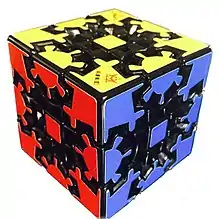 |
Gear Cube | This twisty puzzle was invented by Oskar van Deventer. | |
| Gear Cube Extreme and Gear Cube Ultimate | |||
| Gear Mixup | |||
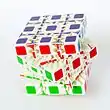 |
Gear Cube 5x5x5 | This was mass-produced by a Chinese company in 2015 using a Shapeways 3D print, without the permission of van Deventer. An agreement was later made with another company to acknowledge his contribution.[13] | |
| David's Gear Cube | |||
| Gear Shift |
References
- "MagicCube5D Hall of Insanity". Archived from the original on 2016-03-03. Retrieved 2012-02-16.
- "2×2×3 (aka: Slim Tower)". TwistyPuzzles.com. Archived from the original on 2016-03-03. Retrieved 2009-06-12.
- "Tower Cube" (in Japanese). Gentosha Education. Archived from the original on 2016-03-04. Retrieved 2012-05-24.
- "2×3×3". TwistyPuzzles.com. Archived from the original on 2016-03-03. Retrieved 2009-06-12.
- "Rubik's Tower 2×2×4". Archived from the original on 2016-02-03. Retrieved 2012-05-24.
- "Specter Cube". TwistyPuzzles.com. Archived from the original on 2016-03-03. Retrieved 2009-06-12.
- "2×2×6". TwistyPuzzles.com. Archived from the original on 2016-03-04. Retrieved 2009-06-12.
- "Collection of cube puzzles". The Puzzle Museum. January 2003.
- Slocum, Jerry (2009), The Cube. The Ultimate Guide to the World’s Best Selling Puzzles Published by Black Dog & Leventhal Publishers, Inc (ISBN 978-1-57912-805-0)
- https://www.thecubicle.com/products/yuxin-huanglong-17x17
- Tony Durham, New Scientist, page 209, 9 September 1982
- "top 5 hardest massproduced puzzles". TwistyPuzzles.com Forum.
- http://oskarvandeventer.nl/How_a_Shapeways_3D-%7Cprint_got_knocked_off_in_China.pdf%5B%5D
External links
| Wikimedia Commons has media related to Sequential move puzzles. |

